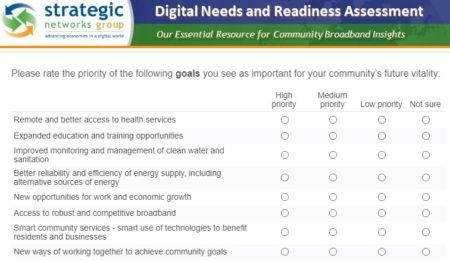Aligning Community Digital Needs and Goals – Are you Ready?
The Digital Needs and Readiness Assessment (DNRA) provides community leaders an objective assessment of where key local stakeholders have consensus on goals and issues that can be addressed through digital infrastructure, as well as an assessment of the current state of broadband and readiness to move forward with an initiative. The DNRA uncovers varying perspectives across stakeholders – whether there is alignment on project success criteria, or whether there are gaps in perspectives or approach. Time, money, and political capital can be saved and common pitfalls avoided by identifying and addressing these gaps early in the planning process. Building a shared vision among elected officials, community leaders, and local stakeholders will grow buy-in around strategies and commitments for the project participants.
The DNRA is normally deployed with the cooperation of one or more local leaders to members of the leadership team in the locality interested in a broadband or smart community initiative. The process is designed to be streamlined to make the most effective use of participant time.
The Assessment
 The Digital Needs and Readiness Assessment is an online questionnaire that typically takes approximately 10 minutes to complete. The questionnaire consists of 25 questions, most of which are multiple choice with a few optional questions to provide additional comments. The assessment can be accessed via a web page link and requires password access. The link and password can be provided to those local leaders invited to participate in the DNRA.
The Digital Needs and Readiness Assessment is an online questionnaire that typically takes approximately 10 minutes to complete. The questionnaire consists of 25 questions, most of which are multiple choice with a few optional questions to provide additional comments. The assessment can be accessed via a web page link and requires password access. The link and password can be provided to those local leaders invited to participate in the DNRA.
Leaders completing the assessment will immediately receive a summary report by email with their individual responses for reference. The DNRA can be taken by one person or by multiple leaders in the locality. In the latter case, when a sufficient number of participants have completed the DNRA, SNG processes the responses for analysis and reporting. The online data collection tool uses a world-class system that ensures the privacy and security of participants, and individual responses are treated as confidential.
The DNRA Report
The DNRA Report summarizes the results of inputs provided by the participating leaders from the locality. The collective responses of the participants are summarized in this report using the following scoring system:
- Individual responses to questions are scored, with higher scores representing more positive response categories – with 100% being the maximum and best score
- An average of the individual participant scores provides an overall score for the question. Score are presented as percentages, with 100% being the maximum and best score.
- Since individual participants do not always agree in their responses, the relative convergence level is calculated on a percentage scale. A convergence of 100% indicates complete agreement among all participants.
- When there is disagreement, the consensus result chosen by a plurality of participants is provided.
The intent of the DNRA scoring system is to reveal areas where the locality may be more ready, or less ready to move forward successfully, as well as areas where more agreement may be required. The scoring is not intended to be “pass or fail” criteria, but as an aid in quickly identifying areas that need attention.
To aid readers in understanding the findings from this report, thresholds are set to distinguish the top one-third (above 66.67% in green shading) and the bottom one-third (below 33.33% in red shading). For example, when evaluating the readiness criteria, the top one-third indicates a high level of readiness, while the bottom one-third indicates a low level of readiness.
 Other DNRA questions, such as those related to community goals and issues, are scored for ranking and determining convergence of opinions. There are no right or wrong goals or issues. Where there is divergence of opinion among the leadership team, those gaps need to be identified, understood, and agreed about how to address them. For each response category, the “consensus” choice is shown representing the selection of the majority of respondents.
Other DNRA questions, such as those related to community goals and issues, are scored for ranking and determining convergence of opinions. There are no right or wrong goals or issues. Where there is divergence of opinion among the leadership team, those gaps need to be identified, understood, and agreed about how to address them. For each response category, the “consensus” choice is shown representing the selection of the majority of respondents.
A number of factors are scored and included in an overall assessment score. An overall score above 71% is a good candidate for pursuing a broadband infrastructure project. Localities with a score below 50% are likely unready to move forward. Those above 50% may be in the process of becoming candidates, but require more information.
The DNRA Report is approximately 10 pages and is structured around the following sections:
 Introduction
Introduction- Digital Needs and Readiness Assessment Summary
- Goals, Issues, and Needs Findings
- Broadband Status Findings
- Readiness Assessment Findings
- Recommendations
Each section provides an average score and convergence level for each DNRA metric, an overall assessment, and any verbatim comments provided by the participants.
Once the DNRA Report is available it will be provided to the locality leadership team and an optional review meeting can be arranged to take the participants through the results. The intent of the report and meeting is for local leaders to achieve a consensus on areas that may need their attention and actions moving forward.



